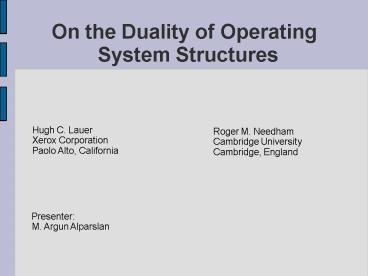On the Duality of Operating System Structures - PowerPoint PPT Presentation
1 / 18
Title:
On the Duality of Operating System Structures
Description:
On the Duality of Operating System Structures. Roger M. Needham. Cambridge University ... Duality Mapping. Performance Issues. Concluding Remarks. Motivation ... – PowerPoint PPT presentation
Number of Views:39
Avg rating:3.0/5.0
Title: On the Duality of Operating System Structures
1
On the Duality of Operating System Structures
Hugh C. Lauer Xerox Corporation Paolo Alto,
California
Roger M. Needham Cambridge University Cambridge,
England
Presenter M. Argun Alparslan
2
Outline
- Motivation
- Two Models
- Duality Mapping
- Performance Issues
- Concluding Remarks
3
Motivation
- Operating Systems fall into two main categories
depending upon notion of process, IPC and
synchronization - Message Oriented Systems
- Procedure Oriented Systems
- Are these two types duals of each other
- Is there a mapping between two?
- Do their performance differ?
4
Message Oriented Systems
- The number of processes and the connections
between them stay relatively static.
Communication among processes are done via
messages (or events). - Each process acts in a relatively static context.
Processes rarely cross protection boundaries and
they rarely share data.(Not necessarily nowadays)
5
Message Oriented Systems
- Synchronization via message queues attached to
processes. (e.g. SEDA) - Priorities are set statically in the system
design - Processes act upon very small number of messages
at a time - Data structures are manipulated via references in
the messages. No process accesses the data unless
it is currently processing a message referring to
it.
6
Messages
- A message is a data structure used for sending
information from a process to another (similar
to MPI) - SendMessagemessageChannel, messageBody returns
messageId -- - AwaitReplymessageld returns messageBody --
- WaitForMessageset of messagePort returns
messageBody, messageld,messagePort - SendReplymessageld, messageBody
7
Resource Manager
- begin m messageBody
- i messageld
- p portld
- s set ofportld
- ... --local data and state information for this
process - initialize
- do forever
- m, i, p - WaitForMessages
- case p of
- port1 gt... --algorithm for poR1
- port2 gt...
- if resourceExhausted then
- s s - port2
- SendReplyi, reply
- . . . --algorithm for port2
- portk gt.
- s s port2
- ... --algorithm for portk
- endcase
8
Procedure-Oriented System
- Protection and addressing based mechanism with
efficient procedure call facilities. - Synchronization is carried out via locks,
semaphores, monitors. - Process creation overhead is low hence large
number of processes - A process has only one job and wanders all over
the system, little or no messaging. - System resources tend to be encoded in global
data structures
9
Procedure Oriented System
- Synchronous calls are made via procedures whereas
asynchronous calls are via - processIdlt-Fork procedureNameparameterList
- resultList lt-Join processId
- Modules as primitive unit of compilation
- Monitors with condtion variablesHoare are used
for resource management - Wait conditionVariable
- Signal conditionVariable
10
Resource Manager
- ResourceManager MONITOR
- C CONDITION
- resourceExhausted BOOLEAN
- .. --global data and state information for this
process - procl ENTRY PROCEDURE. .
- .. --algorithm for procl
- proc2 ENTRY PROCEDURE... RETURNS . .
- BEGIN
- IF resou rceExhausted THEN WAIT C
- ...
- RETURN results
- ...
- END --algorithm for proc2
- ...
- procL ENTRY PROCEDURE...
- BEGIN
- ...
- resourceExhausted FALSE
- SIGNAL C
11
Duality
12
Duality Mapping
- Procedure-oriented system
- Monitors
- ENTRY procedure names
- Simple procedure names
- Procedure call/return
- Simple
- Fork/Join
- Return (from Procedure)
- Wait for lock, condition var
- ENTRY procedures
- Signal, Wait condition variable
- Message-oriented system
- Processes
- Message Channel IDs
- Port numbers
- SndMsgAWaitReply
- Immediate
- Delayed
- SendReply
- WaitForMsg
- Arms of case
- Selective waiting for messages
13
Performance Comparison
- Three components are compared
- Execution times of the programs Same number of
operations in the core algorithms - Computational overhead of the primitive system
operations they call, same complexity - SendFork (allocate, queue, context switch)
- Process switching, VM access can be done equally
efficient - Scheduling, dispatching, preemption equally
efficient - Can use same disciplines
- Queuing and waiting times can be made identical
since the used scheduling policies are same
14
Conclusion
- Choosing which model to adopt relies on 2nd-order
factors - 0th order similar program structure,
performance of client programs - 1st order similar computational complexity
- 2nd order machine architecture features,
programming environment set a priori, emotions
so will drive decisions - Can drive decision closure on process structure
and synchronization using these 2nd order factors
15
Critique
- No rigorous proofs
- Mostly empirical
- Performance arguments hard to believe
- Manual Stack ripping and stack memory
- Events use cooperative scheduling
- Event systems use shared memory
16
Questions?
17
Resources
- "Monitors An operating system structuring
concept.", by C. Hoare, Communications of the
ACM, No. 17, 1974, 549-557. - "SEDA an architecture for well-conditioned,
scalable internet services", by M. Welsh, D.
Culler, E. Brewer, Proceedings of the eighteenth
ACM symposium on Operating systems principles,
2001, 230243. - "Why Events Are a Bad Idea for High-Concurrency
Servers", by R. Behren, J. Condit, E. Brewer,
Proceedings of HotOS III the Ninth Workshop on
Hot Topics in Operating Systems, 2003, 19-24. - A Language-based Approach to Unifying Events and
Threads by Li, Zdancewic, 2006 - Presentation by David Allen from PDX
18
Discussion































